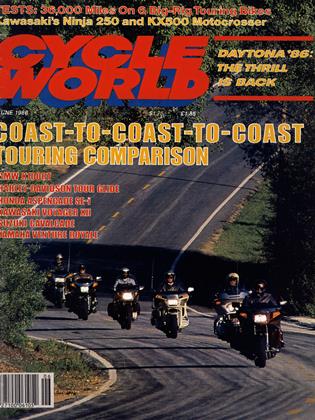1985 KAWASAKI KX250
LONG-TERM TEST
HOW WELL DID THE STRONGEST SURVIVE?
THE FASTEST, BEST-HANDLING bike on the track isn’t worth a damn if it breaks in every other moto. And while a stopwatch or race results can tell you how well any given bike performs, there's just one way to learn about its reliability; ride it. Only time and mileage can determine a new motocross bike’s real worth. If you're lucky, you just might come across a machine that has it all, one that handles well, has blinding acceleration and will last a full season of racing.
Kawasaki’s 1985 KX250 has been such a machine for us. After being subjected to two separate comparison tests, one enduro, six all-day trail rides and 24 motocross races, the KX finally broke —the transmission started jumping out of third. Not a bad record considering that in the majority of races, the bike was ridden by a 1 90-pound motocross Pro noted for his ability to destroy motorcycles. Maintenance on the KX250 dur-
ing the year amounted to replacing three ehains and sprocket sets, three pistons and ring sets, one set of fiber clutch plates, six front tires, eight rear tires, two pairs of rear brake shoes, one air-filter element (stock), one set of front brake pads and one oil change in the rear shock. The engine's transmission oil was changed after each ride, and the swingarm pivot and shock linkage were greased after every four rides—with the exception of the adjustable link, which we greased after every ride.
Lubrication is the key to long rearsuspension life on the KX. We had no problems, but we have seen several bent struts on other 1985 KX motocross bikes. Lack of maintenance and/or misadjustment of the strut most often were the causes of the problem.
Even the frame held up well on Southern California's hard-packed, jump-filled racetracks. The tubes didn't break or bend, although we did
find a small crack in the shock-reservoir bracket and in the right-side swingarm-mounting plate. Both cracks occurred early in our longrange test, but they didn't get any worse even though we never repaired them.
Suprisingly. most of the components normally associated with a short lifespan (in the Pro ranks) held up remarkably well. After all this use, the fork seals don't leak; the seat foam is as good as new; the clutch cable still works smoothly; the wheel bearings are tight; the stock reed valves are still performing fine; there have been no broken plastic parts or wheel spokes, and the grips are just starting to look worn.
We are astounded with the Kawasaki’s durability. Even our Pro test rider can't believe that the KX250 took a full season of his racing abuse without turning to powder. And not only did the KX keep running for a year, it kept winning for a year. 0
 View Full Issue
View Full Issue










